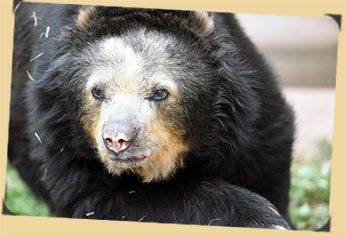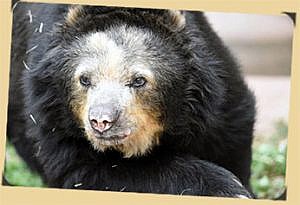— Calf made a big impact on many hearts during her brief life —
Colorado Springs, CO – Cheyenne Mountain Zoo is heartbroken to announce the death of Penny, the giraffe calf. Little Penny was just shy of her two-month birthday when the humane, but extremely difficult, decision was made to euthanize her today.
Penny had been transported to the James L. Voss Veterinary Teaching Hospital at Colorado State University in Fort Collins, CO yesterday for surgical treatment for an infected abscess that was not improving through other treatments. Unfortunately, the expert team there found concerns that were far more serious than originally thought. In addition to the abscess that had spread further into Penny’s abdomen, there were also signs that pointed to infection in the bones of at least three of her legs.
The team also found a dislocated hip joint that multiple X-rays taken over the past several weeks did not show in the past. The team believes the chronic combination of the abscess, a degenerating femoral head and her need to stand awkwardly over an extended period of time led to a recent dislocation.
The highly skilled team at the hospital, along with key members of Penny’s CMZoo care team, discussed potential treatment options for Penny. Because she was facing multiple serious medical concerns, the team determined that her prognosis would be more than she could overcome to live a quality life.
Bob Chastain, president and CEO of Cheyenne Mountain Zoo, said tonight, “We will all miss Penny tremendously. Although our sadness at this time is palpable, we are taking solace in the fact that we truly believe we made the best decisions for her during her short life that we could. It’s always easy, especially in times of grief, to second-guess every decision you made. I have found myself doing that already, and I have cautioned Penny’s care team about this emotion. We will certainly use Penny’s case to help further giraffe medicine in the future, and ensure that the things we have learned from her will live on to help others. And we hope those who have watched Penny’s journey can take comfort in the fact that we made every decision with Penny’s best interests in mind, and we held nothing back from her fans. We were all in this together.”
Penny was definitely a fighter during her short time with us, and so many people around the world fell in love with her through the Zoo’s online documentation of her life – from the live-streaming of her birth, through her first eight days of bonding with her mom and other gentle female members of our herd, and ultimately through the medical struggles that followed her splay at nine days.
The CMZoo team also fell in love with Penny, and they allowed her to be part of her own naming at 10 days old. When the name choices were narrowed down to two finalists, “Mia” and “Penny,” her care team played the songs “Mamma Mia” and “Penny Lane” for her. When she heard the Beatles song, she perked up her ears. From that day on, she was officially known as “Penny,” and affectionately by many of her fans as “Penny Lane.” The original suggestion of the name “Penny” was inspired by Spencer and Julie Penrose, the Zoo’s founders.
Penny’s medical issues derived from her falling on day nine of her life into a splay position. “Splay” is a term used to describe when an animal’s legs go out from under them in an unnatural way. In giraffe, splaying can have varying degrees of severity, from moderately serious to life-threatening.
Since then, Penny’s care team provided around the clock care for her, providing her with everything they could to try to help her recover. They provided her with nourishment through bottle-feeding, and enrichment toys to play with, and assistance in laying down and standing, when she was unable to do it on her own. The Zoo consulted with a wide network of both veterinary and human medical experts along the way.
Although Penny’s own life was brief, her legacy will live on in the work Cheyenne Mountain Zoo is doing to develop cutting- edge medical and husbandry care for giraffe in Zoos around the world.
Penny has also helped to spread the message of the plight of giraffe in the wild.
A team of Cheyenne Mountain Zoo staff and a CSU veterinarian will be traveling to Uganda in the next few days to assist with giraffe conservation efforts as part of Operation Twiga III, in partnership with the Uganda Wildlife Authority (UWA) and Giraffe Conservation Foundation (GCF) to help protect vulnerable giraffe populations in Uganda. Our staff’s contribution to this effort will be dedicated to Penny’s memory.
For those who would like to pay their respects to Penny and thank her care team, the Zoo requests memorial gifts be contributed at www.cmzoo.org/helppenny. Any financial support beyond what is needed to help cover expenses for Penny’s care can be directed to either giraffe conservation or veterinary care for CMZoo animals. In order to direct your gift, please make a note in the “Comments” section online, or on the memo line when writing a check.
Out of respect for the keepers, the giraffe building will be closed to the public on Tuesday and Wednesday (7/31 and 8/1) to allow them some privacy. There will be a box outside of the building for guests to leave cards for the keepers, if they wish.
The Zoo is also starting the process of planning a memorial for Penny, and we will share details soon on how that process will move forward.
About Cheyenne Mountain Zoo
Cheyenne Mountain Zoological Society was founded in 1926. Today, Cheyenne Mountain Zoo, America’s ONLY mountain zoo, offers comprehensive education programs, exciting conservation efforts and truly fantastic animal experiences. It is Cheyenne Mountain Zoo’s hope that guests fall in love with animals and nature, and take action to protect them. Of the 230 zoos and aquariums accredited by the Association of Zoos and Aquariums (AZA), Cheyenne Mountain Zoo is one of just nine operating without tax support. Cheyenne Mountain Zoo depends on admissions, membership dues and donations for funding.


